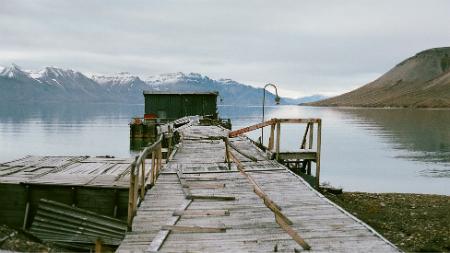On a day in 2011 we find 70-year-old Russian Alexander Ivanovic Naomkin crunching through the snow in the mining town of Piramida on Svalbard, an island that has more polar bears than people, just 1,200 chilly kilometres shy of the North Pole.
"We have a town that's dead, or silent. There's something beautiful about the way Efterklang brings the place to life with the sounds they make."
The mining town was abandoned back in the 20th century. All the workers were returned to Russia from Piramida, which is now decaying in solitude. Soon, however, Alexander runs into two Danes: documentary filmmaker Andreas Koefoed and musician Rasmus Stolberg.
Koefoed films Stolberg, Casper Clausen and Mads Bauer, of the trio Efterklang, as they record the sound of the town and things in it: they blow across the top of bottles, strike things in echoing rooms, drop left-behind bundles of documents to the ground, sending explosions of dust through vacated offices, and run across the many understimulated wooden gangways linking the deserted houses, as if the town were still a living organism.
Recallings of happier days
Koefoed's new documentary, "The Ghost of Piramida", examines the intersection between Alexander's reminiscences of bygone life in the mining town and Efterklang's work of collecting raw sound material for their (then) upcoming album Piramida. Old age longing for youth, youth longing for the future.
On the one hand, with Efterklang, we experience present-day life on Svalbard, shot by Koefoed over eight days without much planning, and on the other hand, we get the result of two well-planned days, directed by Koefoed and shot by Sophia Olsson, of Alexander alone in his Moscow apartment.
Alexander's wife is dead and his memories are stored in the grainy, black-and-white 8mm clips interspersed throughout the film, recalling happier days in Piramida. At night, Koefoed and Olsson submerge the apartment in 8mm projections across the bed and the sleeping Russian in it. The past comes to life in dreams.
"There's a depth to Alexander's footage that mine probably lacks. I was merely exploring the ghost town with Efterklang, but then Alexander's story gave access to the past and to a deeper sense of loss and remembering," Koefoed says.
The filmmaker first earned a bachelor's in sociology before, on his third attempt, in 2005, he was accepted into the National Film School of Denmark. "The Ghost of Piramida" is not his first music documentary. He also made "To the End of the World", about the band The William Blakes. With Christian Bonke, he directed "Ballroom Dancer". And now, on his own, he has made "The Ghost of Piramida", which is screening in IDFA's music documentary competition. It's the sixth Koefoed film in five years to be invited to Amsterdam.
Sound and the absence of it
Sound obviously plays a huge role in "The Ghost of Piramida" – as does the absence of sound.
"It was interesting to work with silence. When I met Alexander up there, his girlfriend told me he stayed silent for two years after his wife died. Silent from grief. He only started speaking again recently."
People become ghosts because they have unfinished business in life. Alexander's nostalgia prevents him from letting go of Piramida. He spent the happiest years of his life there with his wife and children from 1973 until the Russians left in 1998.
What responsibility do you feel for your characters – what is central in your portrayal of them?
"Portraying them so they recognise themselves. That there is truth to what you tell. Then, you might switch around the chronology or plant something: 'Ask him about that' or 'Stand at that edge and look out so I can film you from here'. When you're with people 24/7, you get potential scenes all the time. It's enormously liberating to reduce things beforehand and start assigning an emotion to it in your mind's eye, animating it somehow. Then it becomes personal."
Did you ever drown in reality?
"I think it's hard to be on shoot when you don't know when to take a break. That could very well have been the case on Svalbard, where I hadn't planned what I wanted. But ultimately the material presented itself, once we figured out that the two stories worked together. It cut itself, so to speak."
What do you mean by the concept of silence?
"We have a town that's dead, or silent. There's something beautiful about the way Efterklang brings the place to life with the sounds they make. They also bring his memories back to life and in a way create a sound-setting for his memories. Decay and creation walk hand in hand".
